Abstract
English sole (Parophrys vetulus) inhabiting polluted waterways and embayments of Puget Sound, Washington, are affected with a variety of multiple, co-occurring idiopathic hepatic lesions, including unique degenerative conditions, putatively preneoplastic foci of cellular alteration, and neoplasms. Results of a statistical analysis of the patterns of co-occurrence of these lesions in wild English sole are consistent with the concept that these lesions represent morphologically identifiable steps forming a sequence of progression ultimately leading to the development of hepatic neoplasms. This progressive sequence parallels the pattern identified in experimental models of chemically induced hepatocarcinogenesis in rodents. The rationale for the hypothesis that these lesions in wild English sole can be caused by exposure to certain hepatoxic and hepatocarcinogenic xenobiotic compounds in the marine environment is based on the demonstration of significant and consistent statistical associations between levels of aromatic hydrocarbons (AHs) in sediment and prevalences of these idiopathic liver lesions; a significant contribution by sediment AHs to the variability in hepatic neoplasm prevalence in a logistic regression model; significantly increased probabilities for several idiopathic lesions in sole from chemically contaminated sites in Puget Sound; significant correlations between uptake of polycyclic aromatic hydrocarbons, as measured by levels of fluorescent metabolites of aromatic compounds in bile of sole, and prevalences of several hepatic lesion types; and experimental induction of unique degenerative, proliferative, and putatively preneoplastic focal lesions in English sole injected with either benzo(a)pyrene or a polycyclic aromatic hydrocarbons (PAH) enriched fraction of an extract from a contaminated urban sediment from Puget Sound.(ABSTRACT TRUNCATED AT 250 WORDS)
Full text
PDF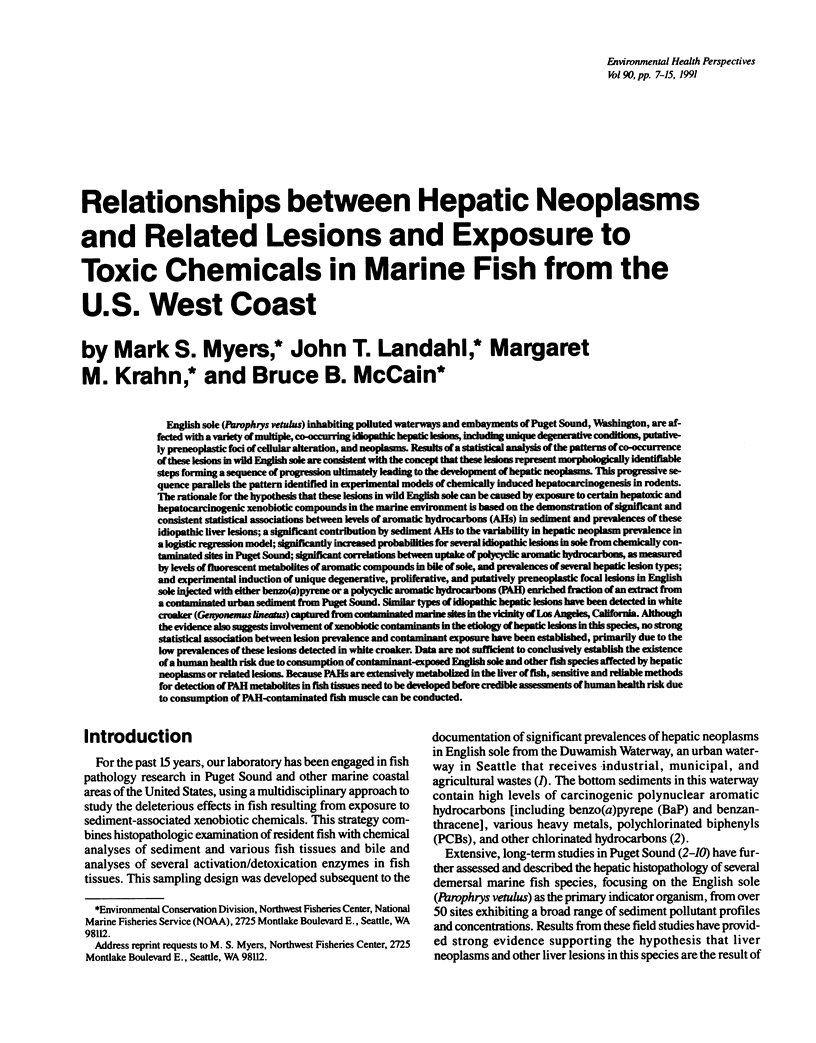

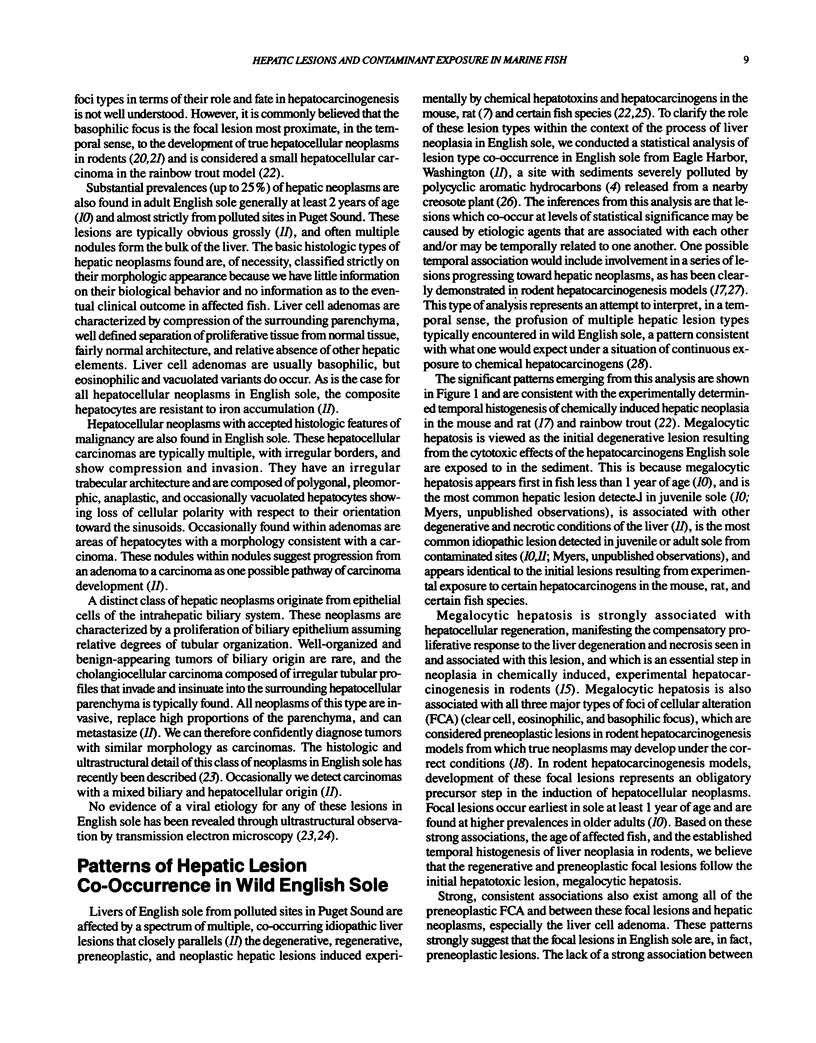
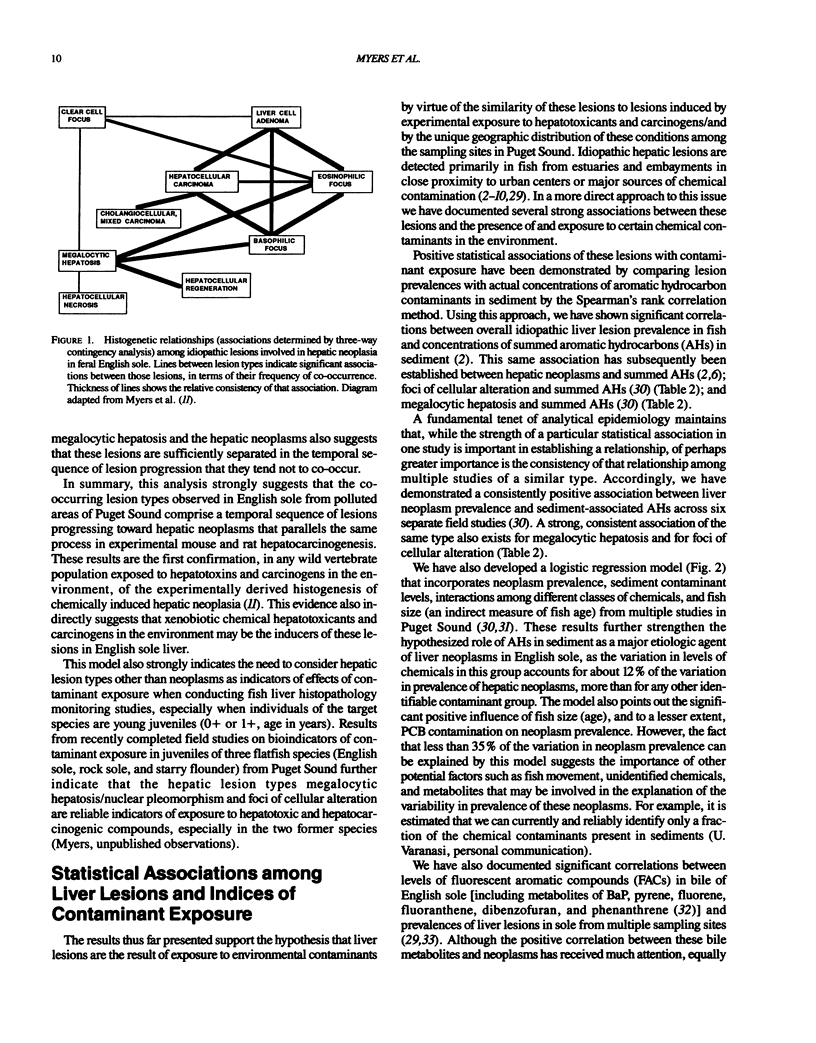
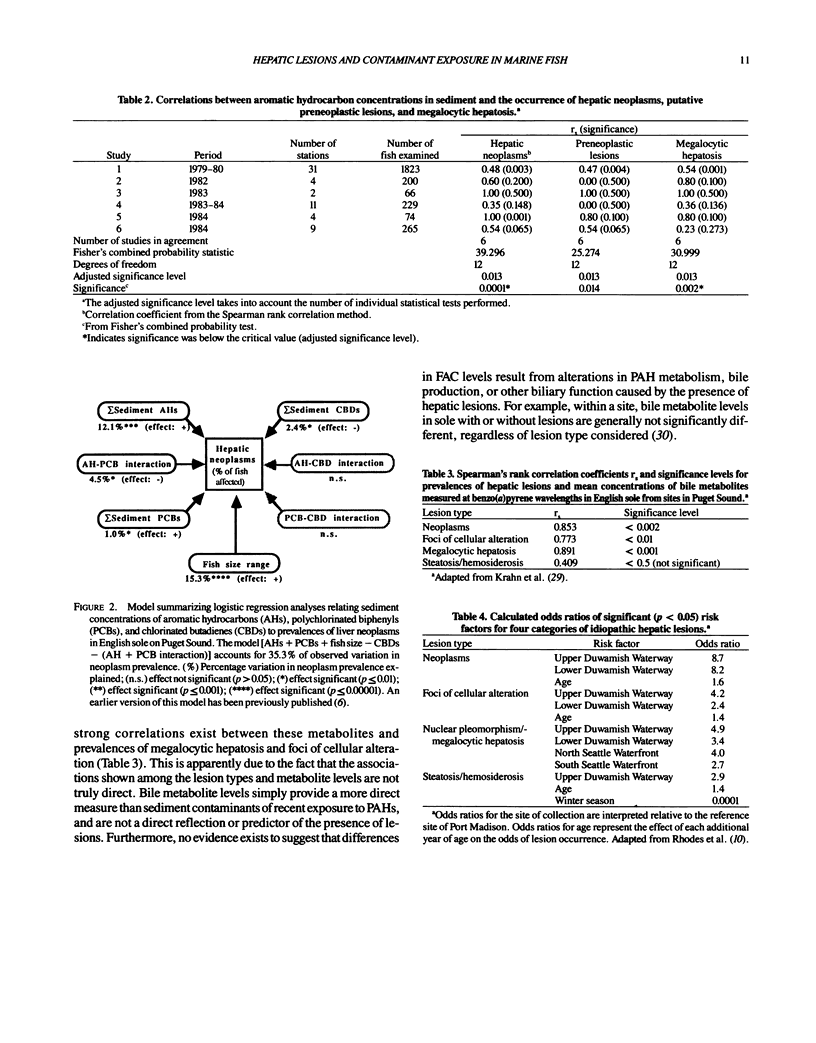
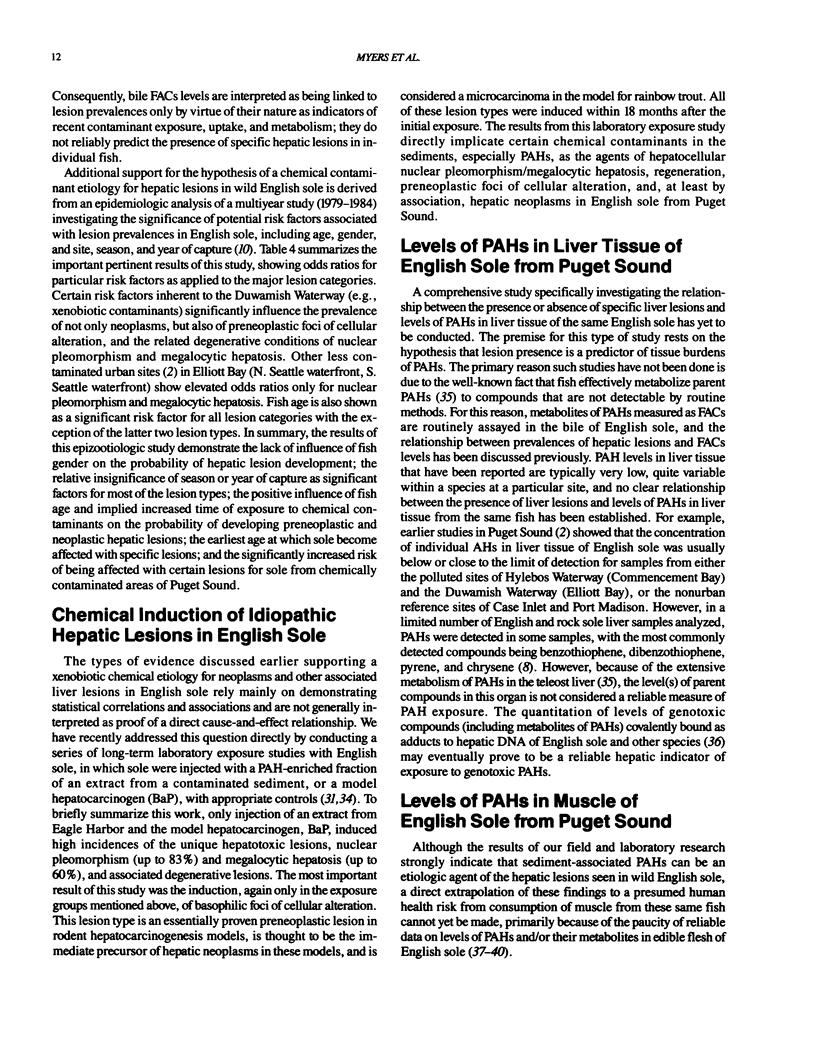
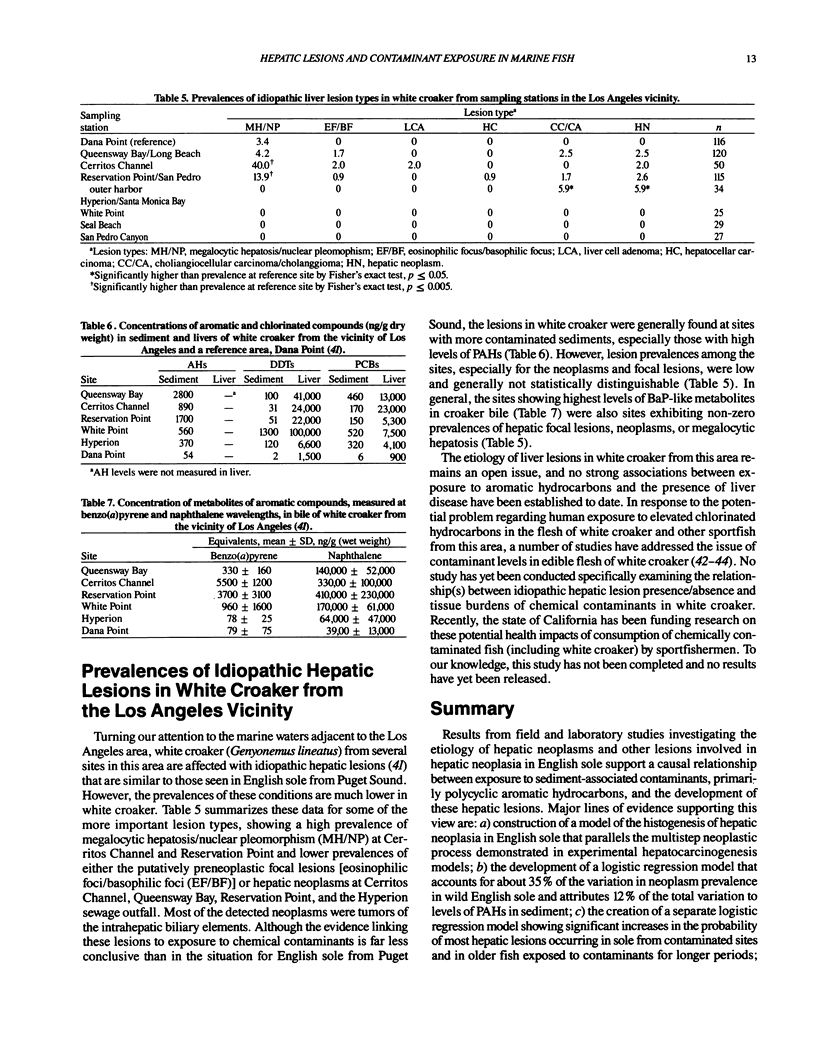
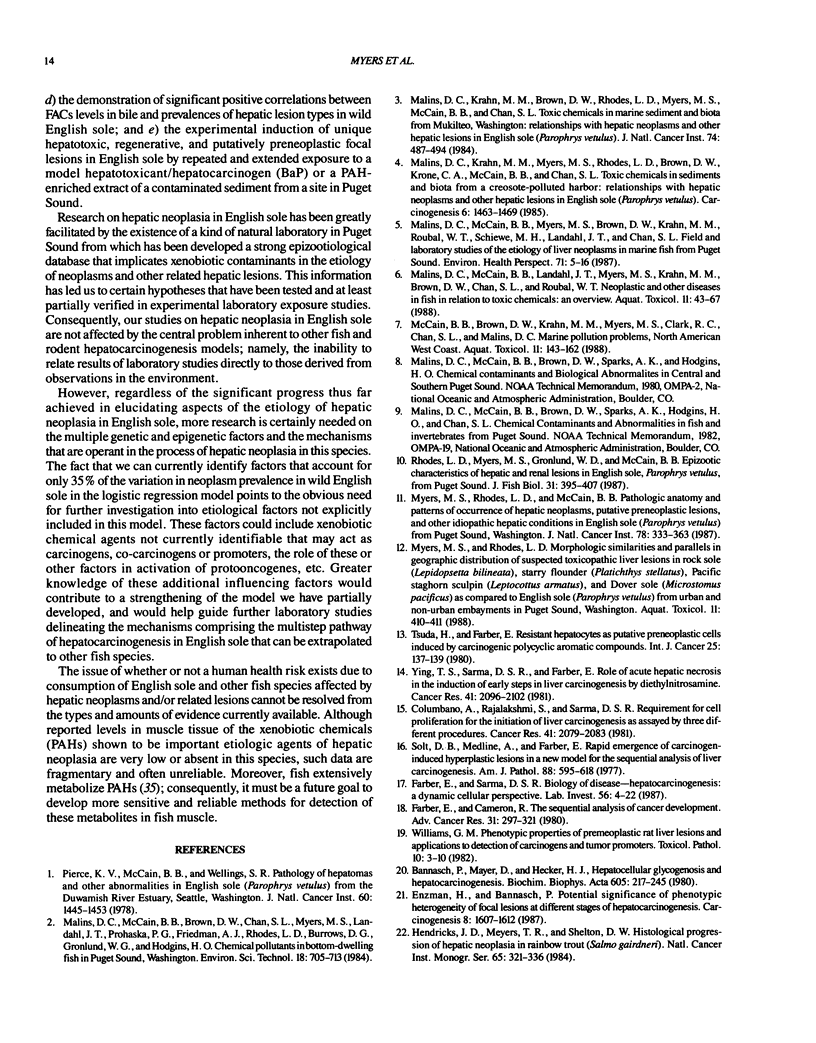
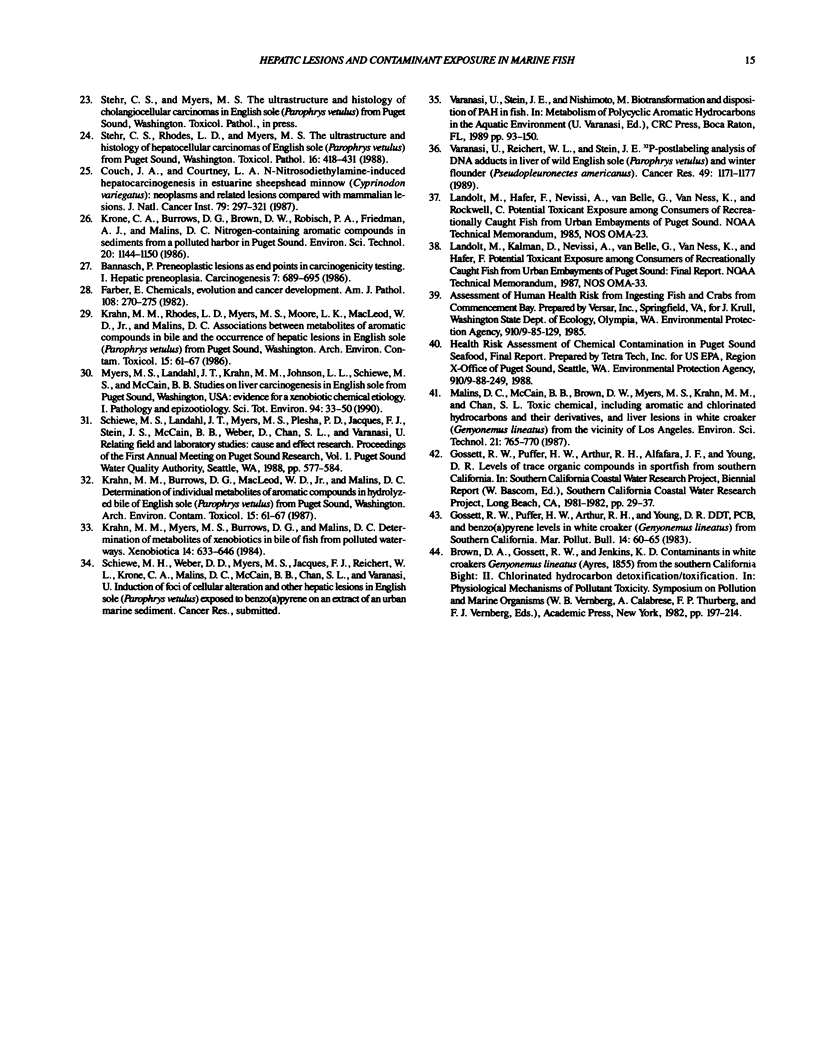
Selected References
These references are in PubMed. This may not be the complete list of references from this article.
- Bannasch P., Mayer D., Hacker H. J. Hepatocellular glycogenosis and hepatocarcinogenesis. Biochim Biophys Acta. 1980 May 6;605(2):217–245. doi: 10.1016/0304-419x(80)90005-0. [DOI] [PubMed] [Google Scholar]
- Bannasch P. Preneoplastic lesions as end points in carcinogenicity testing. I. Hepatic preneoplasia. Carcinogenesis. 1986 May;7(5):689–695. doi: 10.1093/carcin/7.5.689. [DOI] [PubMed] [Google Scholar]
- Columbano A., Rajalakshmi S., Sarma D. S. Requirement of cell proliferation for the initiation of liver carcinogenesis as assayed by three different procedures. Cancer Res. 1981 Jun;41(6):2079–2083. [PubMed] [Google Scholar]
- Couch J. A., Courtney L. A. N-nitrosodiethylamine-induced hepatocarcinogenesis in estuarine sheepshead minnow (Cyprinodon variegatus): neoplasms and related lesions compared with mammalian lesions. J Natl Cancer Inst. 1987 Aug;79(2):297–321. [PubMed] [Google Scholar]
- Enzmann H., Bannasch P. Potential significance of phenotypic heterogeneity of focal lesions at different stages in hepatocarcinogenesis. Carcinogenesis. 1987 Nov;8(11):1607–1612. doi: 10.1093/carcin/8.11.1607. [DOI] [PubMed] [Google Scholar]
- Farber E. Chemicals, evolution, and cancer development: Rous-Whipple Award Lecture. Am J Pathol. 1982 Sep;108(3):270–275. [PMC free article] [PubMed] [Google Scholar]
- Farber E., Sarma D. S. Hepatocarcinogenesis: a dynamic cellular perspective. Lab Invest. 1987 Jan;56(1):4–22. [PubMed] [Google Scholar]
- Hendricks J. D., Meyers T. R., Shelton D. W. Histological progression of hepatic neoplasia in rainbow trout (Salmo gairdneri). Natl Cancer Inst Monogr. 1984 May;65:321–336. [PubMed] [Google Scholar]
- Krahn M. M., Myers M. S., Burrows D. G., Malins D. C. Determination of metabolites of xenobiotics in the bile of fish from polluted waterways. Xenobiotica. 1984 Aug;14(8):633–646. doi: 10.3109/00498258409151461. [DOI] [PubMed] [Google Scholar]
- Krahn M. M., Rhodes L. D., Myers M. S., Moore L. K., MacLeod W. D., Jr, Malins D. C. Associations between metabolites of aromatic compounds in bile and the occurrence of hepatic lesions in English sole (Parophrys vetulus) from Puget Sound, Washington. Arch Environ Contam Toxicol. 1986 Jan;15(1):61–67. doi: 10.1007/BF01055249. [DOI] [PubMed] [Google Scholar]
- Krahn M. M., Rhodes L. D., Myers M. S., Moore L. K., MacLeod W. D., Jr, Malins D. C. Associations between metabolites of aromatic compounds in bile and the occurrence of hepatic lesions in English sole (Parophrys vetulus) from Puget Sound, Washington. Arch Environ Contam Toxicol. 1986 Jan;15(1):61–67. doi: 10.1007/BF01055249. [DOI] [PubMed] [Google Scholar]
- Malins D. C., Krahn M. M., Brown D. W., Rhodes L. D., Myers M. S., McCain B. B., Chan S. L. Toxic chemicals in marine sediment and biota from Mukilteo, Washington: relationships with hepatic neoplasms and other hepatic lesions in English sole (Parophrys vetulus). J Natl Cancer Inst. 1985 Feb;74(2):487–494. [PubMed] [Google Scholar]
- Malins D. C., Krahn M. M., Myers M. S., Rhodes L. D., Brown D. W., Krone C. A., McCain B. B., Chan S. L. Toxic chemicals in sediments and biota from a creosote-polluted harbor: relationships with hepatic neoplasms and other hepatic lesions in English sole (Parophrys vetulus). Carcinogenesis. 1985 Oct;6(10):1463–1469. doi: 10.1093/carcin/6.10.1463. [DOI] [PubMed] [Google Scholar]
- Malins D. C., McCain B. B., Myers M. S., Brown D. W., Krahn M. M., Roubal W. T., Schiewe M. H., Landahl J. T., Chan S. L. Field and laboratory studies of the etiology of liver neoplasms in marine fish from Puget Sound. Environ Health Perspect. 1987 Apr;71:5–16. doi: 10.1289/ehp.87715. [DOI] [PMC free article] [PubMed] [Google Scholar]
- Myers M. S., Landahl J. T., Krahn M. M., Johnson L. L., McCain B. B. Overview of studies on liver carcinogenesis in English sole from Puget Sound; evidence for a xenobiotic chemical etiology. I: Pathology and epizootiology. Sci Total Environ. 1990 May 1;94(1-2):33–50. doi: 10.1016/0048-9697(90)90363-y. [DOI] [PubMed] [Google Scholar]
- Myers M. S., Rhodes L. D., McCain B. B. Pathologic anatomy and patterns of occurrence of hepatic neoplasms, putative preneoplastic lesions, and other idiopathic hepatic conditions in English sole (Parophrys vetulus) from Puget Sound, Washington. J Natl Cancer Inst. 1987 Feb;78(2):333–363. [PubMed] [Google Scholar]
- Pierce K. V., McCain B. B., Wellings S. R. Pathology of hepatomas and other liver abnormalities in English sole (Parophrys vetulus) from the Duwamish River estuary, Seattle, Washington. J Natl Cancer Inst. 1978 Jun;60(6):1445–1453. doi: 10.1093/jnci/60.6.1445. [DOI] [PubMed] [Google Scholar]
- Solt D. B., Medline A., Farber E. Rapid emergence of carcinogen-induced hyperplastic lesions in a new model for the sequential analysis of liver carcinogenesis. Am J Pathol. 1977 Sep;88(3):595–618. [PMC free article] [PubMed] [Google Scholar]
- Stehr C. M., Rhodes L. D., Myers M. S. The ultrastructure and histology of hepatocellular carcinomas of English sole (Parophrys vetulus) from Puget Sound, Washington. Toxicol Pathol. 1988;16(4):418–431. doi: 10.1177/019262338801600402. [DOI] [PubMed] [Google Scholar]
- Tsuda H., Farber E. Resistant hepatocytes as early changes in liver induced by polycyclic aromatic hydrocarbons. Int J Cancer. 1980 Jan 15;25(1):137–139. doi: 10.1002/ijc.2910250118. [DOI] [PubMed] [Google Scholar]
- Varanasi U., Reichert W. L., Stein J. E. 32P-postlabeling analysis of DNA adducts in liver of wild English sole (Parophrys vetulus) and winter flounder (Pseudopleuronectes americanus). Cancer Res. 1989 Mar 1;49(5):1171–1177. [PubMed] [Google Scholar]
- Ying T. S., Sarma D. S., Farber E. Role of acute hepatic necrosis in the induction of early steps in liver carcinogenesis by diethylnitrosamine. Cancer Res. 1981 Jun;41(6):2096–2102. [PubMed] [Google Scholar]


